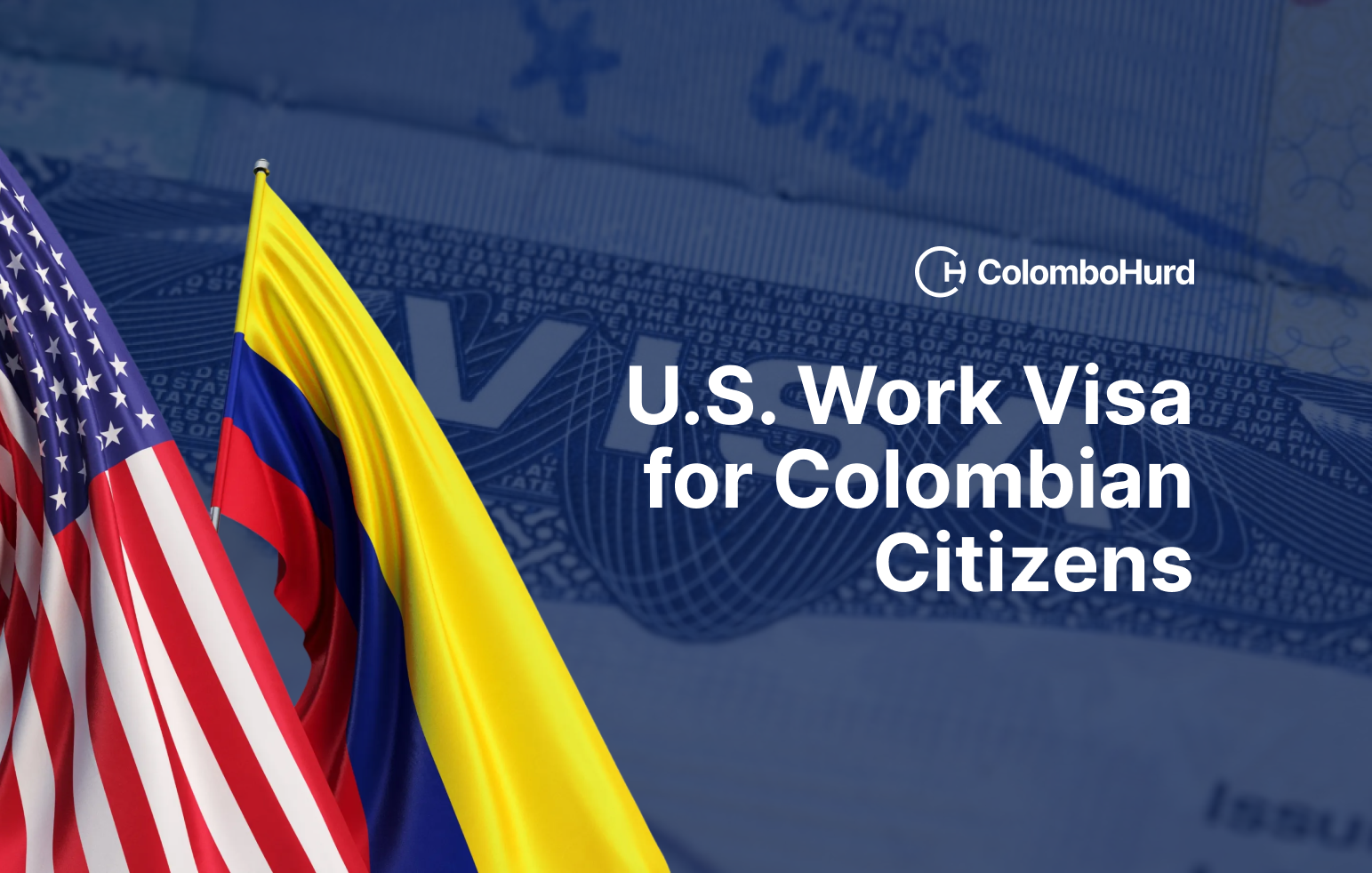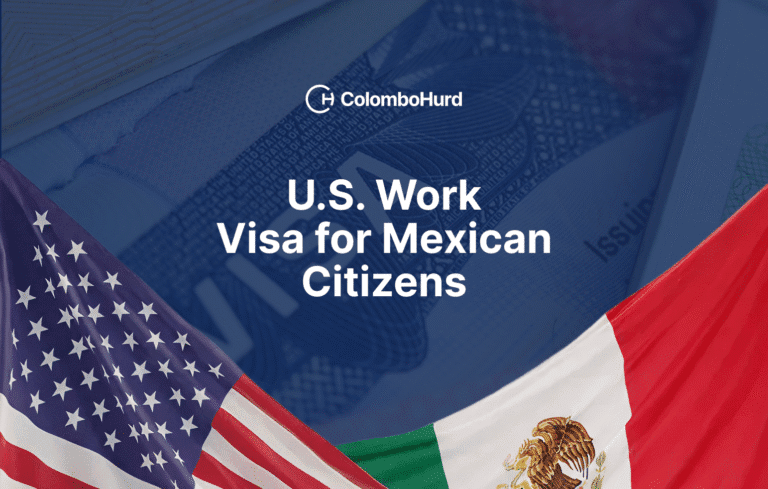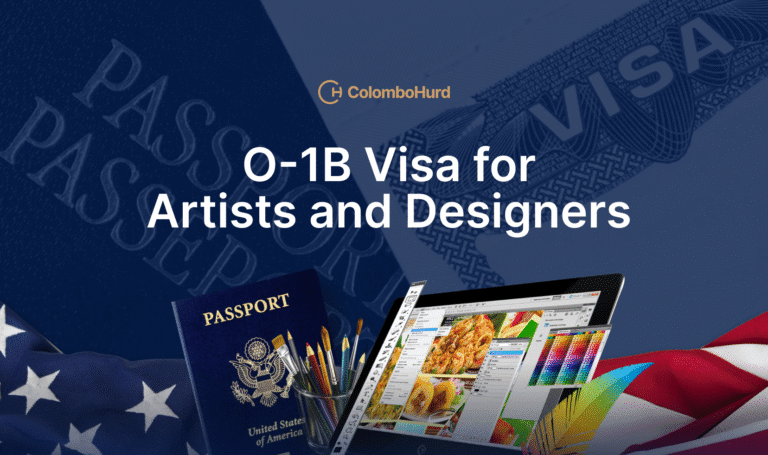
On This Page
- Understanding U.S. Work Visa Categories for Colombians
- EB-1A Extraordinary Ability Green Card
- EB-2 National Interest Waiver
- O-1 Extraordinary Ability Visa
- L-1 Intracompany Transfer Visa
- E-2 Treaty Investor Visa
- EB-5 Immigrant Investor Program
- H-1B Specialty Occupation Visa
- Comparing U.S. Work Visa Options for Colombians
- Choosing the Right Visa Path
- Application Process Overview
- Work Authorization for Colombian Professionals
- Get Help With Your U.S. Work Visa
Colombian professionals have access to multiple pathways for working in the United States. The most suitable visa depends on your qualifications, industry, and long-term goals. High-skilled professionals can pursue self-petition green cards like the EB-1A or EB-2 NIW without employer sponsorship. Others may qualify for temporary work visas including H-1B, L-1, or O-1 status. Colombian entrepreneurs and investors can benefit from the country’s treaty relationship with the U.S. to obtain E-2 or EB-5 visas.
Understanding U.S. Work Visa Categories for Colombians
U.S. work visas fall into two main categories: temporary (nonimmigrant) visas and permanent residence visas (green cards).
Temporary work visas allow you to work in the U.S. for a specific period, typically 1-6 years depending on the category. Most require employer sponsorship and tie your immigration status to your job. These include specialty occupation visas (H-1B), intracompany transfers (L-1), and extraordinary ability visas (O-1).
Employment-based green cards provide permanent residence and unrestricted work authorization. Self-petition categories like EB-1A and EB-2 NIW offer the significant advantage of not requiring employer sponsorship, giving you complete control over your immigration journey and career decisions.
Many professionals start with a temporary visa and later transition to permanent residence. Understanding which pathway aligns with your qualifications and goals is crucial for building a successful immigration strategy.
EB-1A Extraordinary Ability Green Card
The EB-1A visa is for individuals who have reached the top of their field and can demonstrate extraordinary ability. This self-petition pathway allows you to obtain permanent residence without employer sponsorship or job offer.
Who Qualifies for EB-1A
You must demonstrate sustained national or international acclaim in your field. This applies across diverse professions including:
- Technology and AI (data scientists, software engineers, AI researchers)
- Sciences (medical researchers, biomedical engineers, genomics professionals)
- Healthcare (physicians, specialists, healthcare innovators)
- Business (founders, executives, business leaders)
- Arts and entertainment (artists, athletes, performers)
EB-1A Evidence Requirements
You must meet at least three of these ten criteria:
- Receipt of major internationally recognized awards (Nobel Prize, Olympic medal, etc.)
- Membership in associations requiring outstanding achievements
- Published material about you in major media
- Participation as a judge of others’ work in your field
- Original contributions of major significance
- Authorship of scholarly articles in major publications
- Display of your work at artistic exhibitions
- Leading or critical role for distinguished organizations
- High salary or compensation relative to others in your field
- Commercial success in performing arts
Click here for EB-1A processing times
Recent Successes:
- Business Leader (Colombia): After receiving an RFE, this entrepreneur secured EB-1A approval by showcasinginternational leadership and investment impact. He developed cross-border economic programs and drove major business growth in Latin America. USCIS acknowledged his sustained influence in global markets.
- Public Health Innovator (Zimbabwe): This physician earned approval following an RFE by proving his work significantly expanded healthcare access in underserved regions. His rural medical outreach model was adopted nationwide and inspiredglobal public health initiatives. His leadership transformed healthcare delivery for millions.
- Sports Coach (Spain): USCIS granted approval after an RFE once the case demonstrated his extraordinary achievements in coaching and sports education. He guided athletes to national and international success and advanced inclusive training methods. His published research continues to influence physical education across Europe.
EB-2 National Interest Waiver
The EB-2 NIW allows qualified professionals to obtain permanent residence when their work benefits the United States. Unlike traditional employment-based green cards, the EB-2 NIW waives the job offer and labor certification requirements.
EB-2 NIW Eligibility Requirements
You must demonstrate:
- Advanced degree or exceptional ability: Master’s degree or higher, or exceptional ability in sciences, arts, or business
- Proposed endeavor has substantial merit and national importance: Your work addresses critical U.S. priorities
- Well positioned to advance the endeavor: You have the skills, knowledge, and track record to succeed
- On balance, it benefits the U.S. to waive job offer requirements: Your contributions outweigh the need for labor market testing
EB-2 NIW Opportunities in Every Industry
Like the EB-1A, this pathway is not tied to just one field. Impactful contributions are recognized across diverse fields that address national priorities, such as:
- Cybersecurity: Security technologies protecting critical infrastructure
- Healthcare: Disease research, healthcare access, medical device innovation
- Environmental science: Sustainable manufacturing, clean energy solutions
- STEM education: Advancing science and technology education
- Engineering: Infrastructure development, workplace safety systems
Click here for EB-2 NIW processing times.
Recent Successes:
- Workplace Safety Consultant (Colombia): Facing a NOID, the client secured EB-2 NIW approval by clearly linking her conflict-management framework to U.S. workplace safety priorities. She designed training combining emotional intelligence and resilience tools for service teams. USCIS approved the petition, recognizing her innovative contributions to national interest
- Petroleum Engineer (Colombia): In only eight months, and with no RFE, the EB-2 NIW petition was approved. He proposed data-driven automation solutions to optimize oil and gas operations. The approval highlighted both his technical expertise and alignment with U.S. energy modernization goals.
Nurse (Colombia): A Colombian nurse specializing in rare diseases received EB-2 NIW approval by demonstrating how her work addresses national health priorities. She developed programs that integrate research, advocacy, and patient support for systemic impact. USCIS recognized her contributions to U.S. healthcare and rare disease care.
O-1 Extraordinary Ability Visa
The O-1 visa provides temporary work authorization for individuals with extraordinary ability or achievement in sciences, arts, education, business, or athletics.
O-1A vs O-1B Categories
- O-1A: Sciences, education, business, or athletics
- O-1B: Arts or motion picture/television industry
O-1 Evidence Standards
You must demonstrate distinction and a record of excellence through at least three of these criteria:
- Major awards or prizes for excellence
- Membership in associations requiring outstanding achievements
- Published material about you in professional publications
- Participation as a judge of others’ work
- Original contributions of major significance
- Scholarly articles authored by you
- Employment in a critical or essential capacity for distinguished organizations
- High salary relative to others in your field
O-1 Duration and Extensions
Initial O-1 status can be granted for up to three years, with one-year extensions available indefinitely as long as you continue working in your field of extraordinary ability. There is no annual cap, and O-1 holders can pursue green cards without jeopardizing their status.
We secured O-1A approval for an international attorney specializing in complex arbitration cases, including representation in $50 billion litigation against the Russian Federation. The attorney’s track record of handling significant legal matters demonstrated the extraordinary ability required for approval.
L-1 Intracompany Transfer Visa
The L-1 visa facilitates transfers of key employees from international offices to U.S. operations, making it ideal for Colombian companies expanding to the United States or multinational corporations transferring Colombian employees.
L-1A vs L-1B Categories
- L-1A: Executives and managers (up to 7 years)
- L-1B: Employees with specialized knowledge (up to 5 years)
L-1 Eligibility Requirements
You must have worked for the foreign company for at least one continuous year within the past three years. The U.S. and foreign entities must have a qualifying relationship (parent, subsidiary, affiliate, or branch).
L-1A executives must manage the organization or a major component, while L-1B specialists must possess specialized knowledge of the company’s products, services, research, systems, or proprietary techniques.
L-1 to Green Card Path
L-1A executives can transition to EB-1C green cards for multinational managers without requiring labor certification. This makes the L-1A particularly valuable for Colombian executives planning permanent relocation.
Colombian companies with strong presence in industries like energy, banking, and technology frequently use L-1 visas to send trusted managers and specialists to establish or oversee U.S. branches.
E-2 Treaty Investor Visa
Colombian citizens can access E-2 visas due to the treaty of commerce and navigation between Colombia and the United States, effective since June 10, 1948.
E-2 Investment Requirements
The E-2 visa requires:
- Substantial investment: Typically $100,000 or more depending on the business type
- Active enterprise: Investment in a real, operating business (not passive)
- Marginality test: Business must generate more than minimal income
- National ownership: At least 50% owned by Colombian nationals
- Investor role: Coming to develop and direct the enterprise
E-2 Duration and Renewal
E-2 visas can be issued for up to five years at a time and renewed indefinitely as long as the business continues operating. Each entry allows a two-year period of authorized stay. E-2 spouses receive work authorization in the United States.
A Colombian entrepreneur investing $300,000 to open a restaurant or technology startup in the U.S. can move to the country on an E-2 visa to run that business. Key managerial staff from Colombia can also receive E-2 visas if needed.
The E-2 provides significant flexibility for Colombian business owners, though it doesn’t directly lead to a green card. Many E-2 holders later pursue EB-2 NIW or EB-1A green cards based on their business success in the United States.
EB-5 Immigrant Investor Program
The EB-5 visa grants green cards to foreign investors who make qualifying job-creating investments in U.S. commercial enterprises.
EB-5 Investment Amounts
- Standard investment: $1,050,000
- Targeted Employment Area or rural investment: $800,000
The investment must create at least 10 full-time jobs for U.S. workers within two years.
EB-5 Investment Options
Colombian investors typically choose between:
- Direct investment: Create or invest in a new commercial enterprise you actively manage
- Regional Center investment: Invest through USCIS-approved regional centers that pool investor funds for larger projects
Colombian investors have successfully used EB-5 to obtain U.S. residency by investing in various projects, from real estate developments to manufacturing facilities, particularly through regional center programs that handle job creation requirements.
H-1B Specialty Occupation Visa
The H-1B visa allows U.S. employers to hire foreign workers in specialty occupations requiring at least a bachelor’s degree. Common fields include IT, engineering, science, and medicine. However, recent developments show increasing uncertainty: the annual quota, competitive lottery process, and high demand make H-1B selection difficult even for highly qualified applicants.
H-1B Requirements and Process
- Educational requirement: Bachelor’s degree or higher related to the job
- Employer sponsorship: U.S. employer must file petition and obtain Labor Condition Application
- Annual cap: Limited to 65,000 visas per year, plus 20,000 for advanced degree holders from U.S. institutions
- Duration: Initial three-year period, renewable up to six years total
Due to high demand, USCIS conducts a lottery when registrations exceed available visas. Colombian professionals compete in this lottery alongside applicants from all countries.
H-1B Limitations
The annual cap creates uncertainty, and your immigration status remains tied to your employer. Job changes require transfer petitions. Despite these constraints, H-1B provides a pathway to eventual green card sponsorship through the same employer.
Comparing U.S. Work Visa Options for Colombians
| Visa Type | Duration | Employer Required | Path to Green Card | Best For |
| EB-1A | Permanent | No | Direct green card | Top professionals in their field |
| EB-2 NIW | Permanent | No | Direct green card | Advanced degree holders whose work benefits the U.S. |
| EB-5 | Permanent | No | Direct green card | Investors with $800K-$1.05M |
| O-1 | Up to 3 years, renewable | Yes | Possible | Extraordinary ability in field |
| L-1A | Up to 7 years | Yes (transfer) | Via EB-1C | Managers at multinational companies |
| L-1B | Up to 5 years | Yes (transfer) | Possible | Specialized knowledge workers |
| E-2 | 5 years, renewable indefinitely | No (own business) | Not direct | Entrepreneurs with substantial investment |
| H-1B | Up to 6 years | Yes | Possible | Specialty occupation professionals |
Choosing the Right Visa Path
The optimal visa depends on your specific situation:
For high-achieving professionals: EB-1A or EB-2 NIW offer the most autonomy since they don’t require employer sponsorship. You control your immigration status and career decisions completely.
For entrepreneurs: E-2 provides flexibility to establish and run your U.S. business, while EB-5 offers a direct path to permanent residence if you have substantial capital.
For company transfers: L-1 visas facilitate relocation from your Colombian office to U.S. operations, with L-1A executives having a clear path to EB-1C green cards.
For specific job offers: H-1B works for specialty occupations when you have employer sponsorship, though the lottery creates uncertainty.
Many successful immigration strategies combine multiple visa types. For example, entering on an H-1B or L-1 while simultaneously pursuing an EB-2 NIW provides both immediate work authorization and a path to permanent residence independent of your employer.
Application Process Overview
While specific requirements vary by visa category, the general process includes:
For Self-Petition Green Cards (EB-1A, EB-2 NIW)
- Documentation gathering: Compile evidence of your qualifications and achievements
- Petition preparation: File Form I-140 with comprehensive supporting evidence
- USCIS review: Wait for petition adjudication (6-18 months depending on category)
- Visa processing or adjustment: Apply for immigrant visa at U.S. embassy in Bogotá or adjust status if in the U.S.
- Green card receipt: Receive permanent residence authorization
For Employer-Sponsored Temporary Visas
- Job offer: Secure position with U.S. employer willing to sponsor you
- Labor certification: Employer obtains required certifications (if applicable)
- Petition filing: Employer files Form I-129 with USCIS
- Petition approval: Wait for USCIS decision (2-4 months typical)
- Visa application: Apply for visa at U.S. embassy in Bogotá
- Entry to U.S.: Travel to United States and begin work
For Treaty and Investment Visas (E-2, EB-5)
- Investment planning: Develop business plan and commit capital
- Petition preparation: File I-526E (EB-5) or apply directly at embassy (E-2)
- Source of funds documentation: Demonstrate lawful origin of investment capital
- Visa interview: Attend interview at U.S. embassy in Bogotá
- Visa issuance: Receive visa and enter United States
The U.S. Embassy in Bogotá processes visa applications for Colombian citizens. Processing times vary by visa category and current workload.
Work Authorization for Colombian Professionals
Colombian citizens have access to a comprehensive range of U.S. work visa options. Self-petition pathways like EB-1A and EB-2 NIW provide the greatest independence, allowing you to obtain permanent residence based solely on your qualifications without employer sponsorship. These categories align particularly well with Colombia’s growing technology, healthcare, and business sectors.
Temporary work visas including H-1B, L-1, and O-1 serve professionals with specific job offers or company transfers, while E-2 and EB-5 visas support entrepreneurs and investors. Colombia’s treaty status with the United States and inclusion on H-2A/H-2B eligible country lists provide opportunities not available to many other nationalities.
The right immigration strategy depends on your qualifications, industry, career goals, and timeline. Consulting with an experienced immigration attorney can help you identify the optimal pathway and navigate the complex application process successfully.
Get Help With Your U.S. Work Visa
At Colombo & Hurd, we specialize in helping Colombian professionals and entrepreneurs obtain U.S. work authorization. As a firm founded by immigrants for immigrants, we understand your journey personally. Our team has secured over 10,000 successful visa and green card approvals since 2023, including 2,500+ EB-2 NIW and EB-1A approvals in the past three years alone.
We focus on self-petition pathways that give you control over your immigration status, including EB-1A extraordinary ability petitions and EB-2 National Interest Waivers. We also handle O-1, L-1, E-2, and EB-5 cases for qualified professionals and investors.
Our experienced attorneys will evaluate your qualifications, develop a strategic plan, and guide you through every step of the process.




